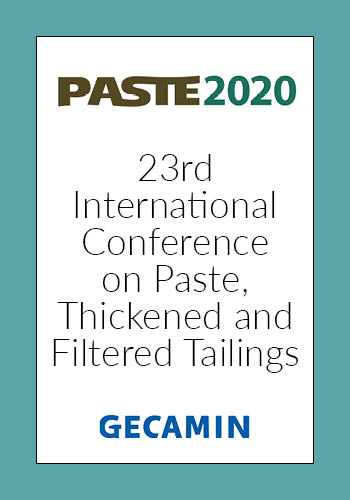Integrating Site Conditions, Rate of Rise and Deposition Sequence to Beach Slope Estimations for High Thickened Tailings

|
Authors: Errázuriz, T; Gonzalez, A |
DOI https://doi.org/10.36487/ACG_repo/2052_30
Cite As:
Errázuriz, T & Gonzalez, A 2020, 'Integrating Site Conditions, Rate of Rise and Deposition Sequence to Beach Slope Estimations for High Thickened Tailings ', in H Quelopana (ed.), Paste 2020: 23rd International Conference on Paste, Thickened and Filtered Tailings, Gecamin Publications, Santiago, https://doi.org/10.36487/ACG_repo/2052_30
Abstract:
The application of highly thickened tailings technologies is rapidly increasing due to the perceived benefits with respect to reduction of environmental impacts, water savings and potential reductions in dam size and footprint impoundment. Evaluation of this potential benefits requires that during early design stages an understanding is developed for the range of feasible beach slopes to be achieved during deposition. A comprehensive evaluation of the whole range of factors that influence the beach formation process is paramount to ensure that expected performance during design stages is met throughout operations. This paper presents an integral approach for beach slope estimation, considering a broader range of aspects affecting the beach formation process than those commonly used in current models (rheology and discharge rate of the deposited tailings). The additional aspects considered by this approach are site conditions (site morphology and climate), the rate of rise of the tailings impounded (the relationship between the tailings production rate and the available area for tailings spreading) and the deposition sequence (the configuration of the deposition system and its operation, e.g. thin layer deposition with drying cycles). The approach is supported by a beach slope model based on a dimensionless parameter for non-Newtonian flows, associated with sheet flows on an inclined plane, which directly relates to the tailings beach slope expected to be formed due to sub-aerial disposal. This dimensionless parameter provides a closed expression for estimating tailings beach slopes based on rheological properties and discharge rates, but with the integration of site conditions, rate of rise and deposition sequence. High thickened tailings management facility (TMF) design is well supported by this approach, providing key input as the configuration of the distribution system and the minimum area required to achieve expected performance with respect to desired beach slope, density, degree of saturation and strength.
References:
McPhail, G. (2008). ‘Prediction of the beach profile of high-density thickened tailings from rheological and small-scale trial deposition Data ‘, Proceedings of the 11th International Seminar on Paste and Thickened Tailings, Paste 2008.
Fitton, T.G. and Slatter, P.T. (2013). ‘A tailings beach slope model featuring plug flow’, Proceedings of the 16th International Seminar on Paste and Thickened Tailings, Paste 2013.
Errazuriz, T. (2018). ‘Tailings beach slopes as a dimensionless parameter of non-Newtonian flows’, Proceedings of the 21st International Seminar on Paste and Thickened Tailings, Paste 2018.
Wilson, G., Fredlund, D. and Barbour, S. (1994). ‘Coupled soil-atmosphere modelling for soil evaporation’, Canadian Geotechnical Journal, 1994, 31 (2): 151-161.
Fisseha, B., Bryan, R. and Simms, P. (2010). ‘Evaporation, Unsaturated Flow, and Salt Accumulation in Multilayer Deposits of “Paste” Gold Tailings’. Journal of Geotechnical and Geoenvironmental Engineering 136: 1703-1712.
Jefferies M. and Been, K. (2015). Soil liquefaction: a critical state approach, 2nd Ed., Taylor and Francis.
Jewel, R. (2010). ‘The evolution of paste and thickened tailings’, Newsletter volume No. 35, December 2010. Australian Centre for Geomechanics.
Simms, P., Sivathayalan, S. and Daliri, F. (2013). ‘Desiccation in dewatering and strength development of high-density hard rock tailings’, Proceedings of the 16th International Seminar on Paste and Thickened Tailings, Paste 2013.
Li, A. (2011). ‘Prediction of tailings beach slopes and tailings flow profiles’, Proceedings of the 14th International Seminar on Paste and Thickened Tailings, Paste 2011.
Fitton, T.G. (2007). ‘Tailings beach slope prediction’, PhD thesis. RMIT University, Australia, Published as book by VDM Verlag, Saarbrücken, Germany 2010.
Peck, R. (1969) ‘Advantages and Limitations of the Observational Method in Applied Soil Mechanics’, 9° Rankine Lecture.
D’Appolonia, E. (1990). ‘Monitored Decisions’, 24° Terzaghi Lecture, ASCE Journal of geotechnical engineering, Vol 16.
© Copyright 2025, Australian Centre for Geomechanics (ACG), The University of Western Australia. All rights reserved.
View copyright/legal information
Please direct any queries or error reports to repository-acg@uwa.edu.au
View copyright/legal information
Please direct any queries or error reports to repository-acg@uwa.edu.au